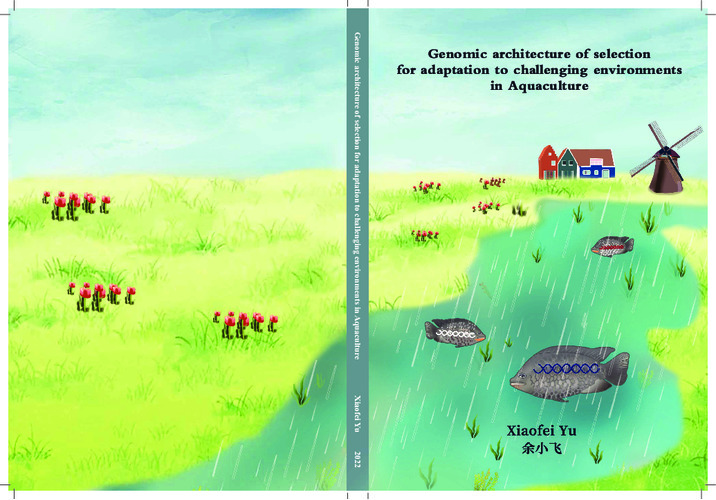Please use this identifier to cite or link to this item:
https://hdl.handle.net/20.500.12348/5413
Genomic architecture of selection for adaptation to challenging environments in aquaculture
| dc.creator | Yu, X. | en_US |
| dc.date.accessioned | 2023-01-21T09:10:50Z | |
| dc.date.available | 2023-01-21T09:10:50Z | |
| dc.date.issued | 2022 | en_US |
| dc.identifier.citation | Xiaofei Yu. (13/12/2022). Genomic architecture of selection for adaptation to challenging environments in aquaculture. Wageningen, Netherlands: Wageningen University & Research Centre (WUR). | en_US |
| dc.identifier.isbn | 9789464474695 | en_US |
| dc.identifier.uri | https://hdl.handle.net/20.500.12348/5413 | |
| dc.description.abstract | Aquaculture, including freshwater and marine farming, has been important for global fish production during the past few decades. However, climate change presents a major risk threatening both quality and quantity of aquaculture production. The environmental stressors in aquaculture resulting from climate change, are temperature rise, salinity changes, sea level rise, acidification and changes of other chemical properties and changes of oxygen levels. Although a reasonable genetic gain can be achieved by selective breeding, this genetic response may not be enough to adapt fish species to the effects of climate change. Marker assisted selection focusing on specific genes or alleles that allow fish to cope with these changes would allow more rapid adaptation of fish to these new environments. In this thesis, I focused on three essential environmental stressors - dissolved oxygen, salinity and temperature as primarily determined in aquaculture production. The main objective is to provide insight in the genomic architecture underlying the mechanism of adaptation to challenging environments of aquaculture species under farming conditions. First, I determined candidate QTL associated with phenotypic variation during adaptation to hypoxia or normoxia. I identified overrepresented pathways that could explain the genetic regulation of hypoxia on growth. To identify fish with better hypoxia tolerance and growth under a hypoxic environment, I quantified the genetic correlations between an indicator trait for hypoxia tolerance (critical swimming performance) and growth. Moreover, the genomic architecture associated with swimming performance was demonstrated, while the effect of significant QTLs on growth was estimated. Beyond applying genome-wide association studies, I used selection signatures to identify QTLs and genes contributing to salinity tolerance. In addition, I also compared the genome of the saline-tolerant and highly productive tilapia “Sukamandi”, that was developed by the aquaculture research institute in Indonesia, to that of blue tilapia and Nile tilapia, to identify the QTLs contributing to salinity tolerance. Finally, I investigated QTLs associated with growth-related traits and organ weights at two distinct commercial Mediterranean product sites differing in temperature (farms in Spain and Greece). Overall, this thesis considerably adds to insight into how fish adapt to challenging environments, which will aid marker-assisted selection for improved resilience of aquaculture species under climate change. | en_US |
| dc.format | en_US | |
| dc.language | zh, en | en_US |
| dc.publisher | Wageningen University & Research Centre (WUR) | en_US |
| dc.rights | Copyrighted; Non-commercial educational use only | en_US |
| dc.subject | traits | en_US |
| dc.title | Genomic architecture of selection for adaptation to challenging environments in aquaculture | en_US |
| dc.type | Thesis | en_US |
| cg.contributor.crp | Fish | en_US |
| cg.contributor.funder | Wageningen University & Research Centre | en_US |
| cg.contributor.funder | WorldFish | en_US |
| cg.contributor.funder | Koepon Stichting (Koepon Foundation) | en_US |
| cg.coverage.country | Malaysia | en_US |
| cg.coverage.country | Netherlands | en_US |
| cg.coverage.region | South-Eastern Asia | en_US |
| cg.coverage.region | Western Europe | en_US |
| cg.subject.agrovoc | adaptation | en_US |
| cg.subject.agrovoc | selection | en_US |
| cg.subject.agrovoc | salinity | en_US |
| cg.subject.agrovoc | architecture | en_US |
| cg.subject.agrovoc | genomics | en_US |
| cg.subject.agrovoc | tilapia | en_US |
| cg.subject.agrovoc | fish genetics | en_US |
| cg.subject.agrovoc | Fish | en_US |
| cg.contributor.affiliation | Wageningen University & Research Centre | en_US |
| cg.contributor.affiliation | The French Agricultural Research Center for International Development | en_US |
| cg.contributor.affiliation | WorldFish | en_US |
| cg.contributor.affiliation | University of Edinburgh, College of Medicine & Veterinary Medicine, The Roslin Institute | en_US |
| cg.identifier.status | Open access | en_US |
| cg.description.theme | Sustainable aquaculture | en_US |
| dc.identifier.doi | https://dx.doi.org/10.18174/579733 | en_US |
Files in this item
This item appears in the following Collection(s)
-
Sustainable aquaculture [2735]
